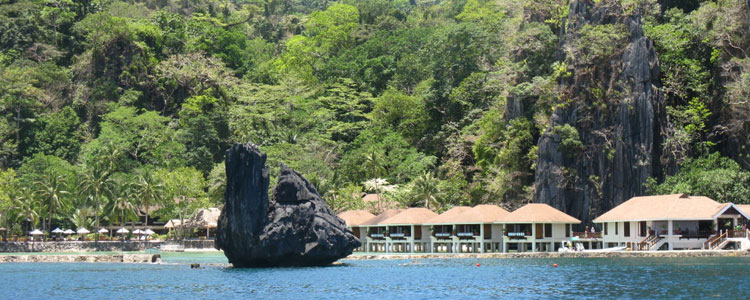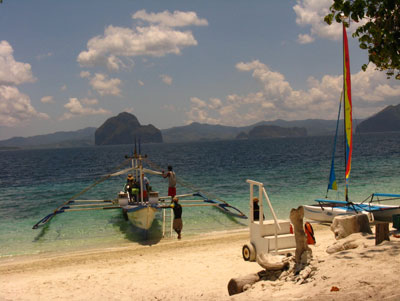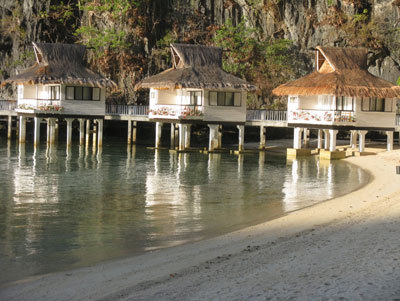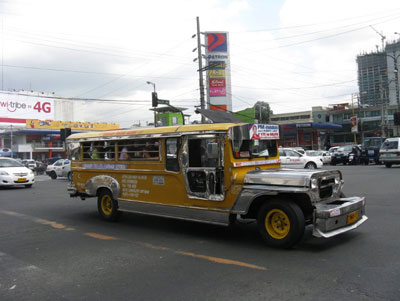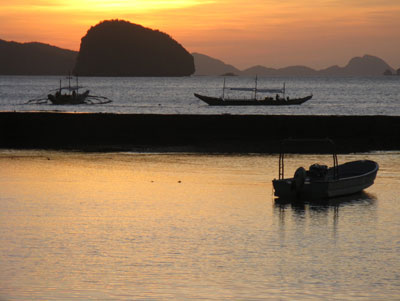Discovering an island paradise in the Philippines
by Larry Taylor; Fullerton, CA. Photos by Gail Taylor.
In my opinion, El Nido (head office, Makati City, Luzon; phone +63 2 894 5644, www.elnidoresorts.com) is absolutely the world’s best tropical island getaway.
Located in the Philippines’ Palawan islands, it actually comprises two resorts, each located a short boat ride from the other. Among its many virtues are accommodations that rank with the world’s most highly rated resort hotels; an international menu featuring delicious selections, and activities to satisfy the most adventurous traveler as well as visitors seeking relaxation and pampering — all included in the price.
The resorts
The resorts are situated on Miniloc and Lagen islands, a 75-minute flight from Manila plus a 45-minute boat ride from El Nido’s village airport. I found both locations, less than an hour’s boat ride apart, to be equally excellent.
The resort on Miniloc, constructed in 1981, is the oldest. Built right off the beach, the property is shaded by palm trees and framed by a backdrop of sheer limestone cliffs. While both resorts each have 50 air-conditioned rooms, Miniloc’s feature thatch roofs built with indigenous Filipino materials. Some rooms are over the water; others are on the sand. In the rear, garden and cliff cottages nestle high on the hillside. All face the bay.
On Lagen, many of the rooms are set in a lush forest several yards from the beach and pier. The sprawling grounds, covering more than 400,000 square feet, contain a diverse variety of birds and mammals — a great place for birders and hikers.
Lagen offers more amenities, including a swimming pool and spa suite. A variety of accommodations is available at this location as well: water cottages built on stilts, beachfront units with excellent sunset views and rooms on the edge of the forest.
Daily activities
During dinner each night, an activity coordinator visited guests to schedule activities for the next day. Among available options were diving and snorkeling; sea kayaking; rock climbing; hiking; fishing, and boat excursions.
We are avid snorkelers, so we would select sites from the many prime locations listed. We were even provided with our own snorkeling guides: Chito Socito at Miniloc and Rafael Dalabujan at Lagen. The two knew exactly where to go and pointed out many fish and corals we otherwise would have missed.
We usually went on two snorkels in the morning at different locations, then, following lunch and a nap, an afternoon snorkel. Ahhh, the island life!
On our last afternoon, we took the trail at the back of the Lagen property, which led through the forest to a private cove. It was steep, but there was a rope installed on the path to help us climb the slopes and steady ourselves during our descent.
Along the way a family of long-tailed macaque monkeys “greeted” us from up in the trees. They seemed to taunt us, vigorously shaking leaves from the tree limbs onto the path.
The trail ended on the beach, and Rafael was there with our snorkel equipment. After resting, we set out for the spectacular hour-long snorkel back to the resort.
We swam past gorgeous corals and sea life, saw many varieties of colorful wrasse, several pennant fish and varied species of butterflyfish and were amazed by the vibrant colors of the clownfish.
Upon reaching the pier, we were worn out but exhilarated by our adventurous day.
Rubbing elbows
One of the most interesting things we did at El Nido was talk to other travelers from around the world. At the bar at sunset, we discussed the merits of vodka and beer with a group of Russians. On a snorkel trip with a Frenchman, we talked about President Sarkozy’s policies.
Filipinos make up half of those visiting the resort, followed in numbers by Koreans and Japanese. From many Asian cities, the islands are only a few hours away by plane.
There was also a significant number of Australian and European guests. We saw only a few people from the United States, however.
Though the 14-hour flight from Los Angeles can be daunting for some, we have found no better tropical vacation spot, especially for the price. The all-inclusive rate averaged about $200 per person per night.
On to Manila
After our stay at El Nido, we decided to spend two days in Manila. On a previous visit to the Philippines, we had decided not to visit this capital city, which we perceived as congested and unappetizing. This time (April 2010) we opted for a short stay.
As expected, the drive to our hotel was traffic-clogged as we wended our way through motor scooters and the ubiquitous garishly decorated jeepney taxis. Our destination was the excellent Mandarin Oriental (phone +63 2 750 8888, www.mandarinoriental.com/manila), located among tall skyscrapers in the Makati financial district. Room rates start at $165 per night — a great price for these deluxe accommodations.
We could tell at once that this was a thriving cosmopolitan city.
For dinner on our first night, the concierge recommended Grappa’s Italian restaurant (phone 632 757 4908). It was located in the Greenbelt shopping mall, a tourist destination in itself, offering a mix of shops, restaurants and entertainment spots.
We were told it was only a 20-minute walk to the restaurant, which should have set off a warning note. As veteran travelers, we know “just a few minutes” can turn into a 45-minute nightmare. Needless to say, that is what happened to us.
It was a hot night, and midway on the walk we regretted not taking a taxi. We soldiered on and found the mall. After asking several bystanders and security people (nearly all Filipinos speak English), we made it.
We revived ourselves with Pellegrino mineral water, then had a very good meal of eggplant Parmesan and ravioli (total, $35). Overall, it ended up being a good experience.
Touring the city
The next morning, while we were having breakfast and checking guidebooks for places to go, a British couple overheard our conversation. They chimed in, saying that they highly recommended the guide Carlos Celdran and his “If These Walls Could Talk” tour of Intramuros, the old city of Manila. We took their suggestion. The hotel staff seconded the choice, booking us for the 4 p.m. tour ($24).
After breakfast, we decided to go to the Ayala Museum, which happened to be adjacent to the Greenbelt. We now had no qualms about walking there. (We did, however, have to forgo visiting the acclaimed National Museum, across town, because of time constraints.) The Ayala, with its permanent collection of works by contemporary Filipino artists and a diorama on the country’s history and culture, was an excellent place to learn more about the Philippines.
An animated amble
In the afternoon, at the gates of Fort Santiago, the colorful Carlos Celdran (e-mail celdrantours@hotmail.com) greeted us in a tophat and shorts, carrying a speaker and a satchel of props. His theatrical style and witty, articulate presentation made the 2½-hour walk both enjoyable and informative.
About half the people in our group of 27 were Filipinos, eager to learn more about the history of their country. They joined in as Carlos put on the Philippine national anthem while twirling the Philippine flag.
We were led to the impressive statue of Santiago Matamoros (St. James the Moorslayer), where we were told about Spain’s occupation of the Philippines from the 16th through 19th centuries. As Celdran recounted the corrupt control of the country by evangelical Catholic priests, he role-played various Spaniards and friars, skewering frailties with his sharp remarks.
The Filipinos cheered when Celdran brought in national hero José Rizal, whose memorial is in the adjacent Rizal Park. He was a writer whose antigovernment novels helped spur citizens to revolt in the late 1800s.
At this point, horse-drawn carriages arrived to convey the group to the Church of San Agustin. One of the few buildings to survive the World War II bombings intact, San Agustin has an adjoining monastery, which now houses a museum containing many valuable colonial religious paintings.
Beginning his tour’s final section, which detailed the US occupation, Celdran emerged in Uncle Sam regalia while “The Star-Spangled Banner” played. Coming to World War II, he donned a general’s hat and dark glasses and stuck a corncob pipe in his mouth, morphing into Douglas MacArthur, America’s leader of the Pacific campaign.
San Agustin was also the site of a memorial for those killed in the 1945 bombing of Manila by US planes to counter Japanese atrocities taking place in the capital. Going into a serious mode, Celdran talked about the tragic consequences of the event.
The tour finished on a lighter note, dealing with the Philippines gaining its independence following the war. To conclude the tour, we were treated to a halo-halo, the national dessert, made from a mixture of sweet, preserved beans, coconut, jackfruit, yams, plantains, cream and milk. Crushed ice is added and it’s all served in a clear glass — a colorful, multilayered sight.
Reluctantly, we had to leave the next day, our stay having been all too short. Manila is certainly worth spending several days (once you’re past the congestion on the roads from the airport).

